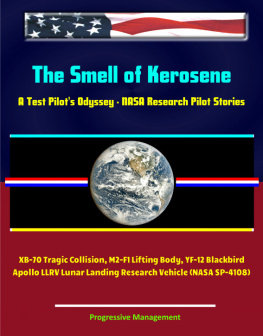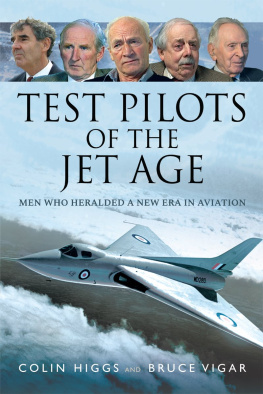
THE WORLDS FASTEST ROCKET PLANE AND THE PILOTS WHO USHERED IN THE SPACE AGE
JOHN ANDERSON AND RICHARD PASSMAN

First published in 2014 by Zenith Press, a member of Quayside Publishing Group, 400 First Avenue North, Suite 400, Minneapolis, MN 55401 USA
2014 Zenith Press
Text 2014 Smithsonian Institution
All photographs are from the authors collection unless noted otherwise.
All rights reserved. With the exception of quoting brief passages for the purposes of review, no part of this publication may be reproduced without prior written permission from the Publisher. The information in this book is true and complete to the best of our knowledge.
Zenith Press titles are also available at discounts in bulk quantity for industrial or sales-promotional use. For details write to Special Sales Manager at MBI Publishing Company, 400 First Avenue North, Suite 400, Minneapolis, MN 55401 USA.
To find out more about our books, join us online at www.zenithpress.com.
Digital edition: 978-1-61058-927-7
Softcover edition: 978-0-76034-445-3
Library of Congress Cataloging-in-Publication Data
Anderson, John, 1937
X-15 : the worlds fastest rocket plane and the pilots who ushered in the space age / John Anderson, Richard Passman.
pages cm (Smithsonian series)
Summary: The X-15, which flew from 1959-1970, is still the most advaanced research aircraft ever developed and flown, and hangs in a place of honor in the Smithsonians Air and Space Museum. Its test pilots not only reached the edge of space, but their skill and daring helped engineers understand hypersonic speed and thus pave the way for the Space ShuttleProvided by publisher.
ISBN 978-0-7603-4445-3 (hardback)
1. X-15 (Rocket aircraft)History. 2. Aerodynamics, HypersonicResearchUnited StatesHistory. I. Passman, Richard. II. Title. III. Title: Worlds fastest rocket plane and the pilots who ushered in the space age.
TL789.8.U6X513 2014
629.13338--dc23
2013036904
Editor: Elizabeth Demers
Design Manager: James Kegley
Designer: Chris Fayers
Cover Designer: Simon Larkin
On the front cover: NASM
CONTENTS
00 PREFACE
T he X-15 is exciting, even on paper. A rocket-powered airplane, the X-15 carries only 90 seconds worth of fuel. It must be taken aloft under the wing of a B-52 bomber to an altitude of 45,000 feet, then dropped at a Mach number of 0.8. Falling at the acceleration of gravity (32.2 feet per second, every second), the X-15 pilot must engage the engine. Then, using his limited fuel supply, he climbs to a maximum altitude of 352,400 feet or accelerates to Mach 6.7 (6.7 times the speed of sound). He returns to Edwards Air Force Base, perhaps 300 miles distant, decelerating without power through hypersonic Mach 6 and 5, supersonic Mach 4, 3, and 2, and then the sonic speed of 1 before guiding the aircraft to land at 200 miles per hour. The entire time of fight from drop to touchdown on the desert floor usually lasts about 10 minutes.
X-15 nestled under the wing of its B-52 mother ship. USAF, Air Force Flight Test Center History Office, Edwards Air Force Base
The X-15 was a research aircraft, part of a program designed to study the problems of hypersonic flight. For that purpose, the planes Mach number range had to be above 5, and its practical altitude range likewise had to be between 100,000 feet to about 350,000 feet, above which not enough of the sensible atmosphere exists to exert a useful aerodynamic effect. There is no sudden change in airflow characteristics in progressing faster from supersonic flow to hypersonic flow as there is from transonic to supersonic flow, where shock waves form and a so-called sonic boom occurs (and where the myth of a sound barrier was created in the 1930s, suggesting that airplanes could never fly faster than sound). The X-15 was designed to explore Mach numbers and altitudes at speeds and heights never previously achieved by manned flight in order to learn about aerodynamic heating, stability, and control. Another purpose was to generate the engineering data that would be gathered for use on future hypersonic aircraft designs, such as the Space Shuttle.
MACH NUMBERS
Sound moves at a finite speed through air. Its speed depends on the temperature of the air; as the air gets hotter, sound travels faster. At standard sea level conditions, the speed of sound is 340 meters per second, or 761 miles per hour. At 70,000 feet of altitude, where the air is cooler, the speed of sound is 660 miles per hour. Mach number is defined as the ratio of the speed of a vehicle to the speed of sound in the surrounding atmosphere. For example, an airplane flying at a velocity of 4,620 miles per hour at 70,000 feet is flying at seven times the speed of sound, or Mach 7. This leads to the definition of different flight regimes. The subsonic regime is where flight is less than Mach 1. Transonic flight is just below, to just above, Mach 1. Supersonic flight occurs at Mach numbers above 1, and hypersonic flight is considered to be flight at Mach 5 or higher.
Bill Dana and the X-15. NASA
On October 24, 1968, pilot Bill Dana landed the X-15 airplane following what would turn out to be its 199th and last flight. He had reached a Mach number of 5.38 and an altitude of 255,000 feet. The rocket engine had been at 100 percent thrust of 57,000 pounds for 84 seconds, and the whole flight from launch to touchdown had taken a mere 11 minutes and 28 seconds. This achievement followed nine years of testing that had begun with Scott Crossfields first unpowered X-15 flight on June 8, 1959, in which the B-52 mother airplane dropped Crossfield and the X-15 at Mach 0.8 and an altitude of 37,550 feet. That flight, strictly a glide flight, lasted only 4 minutes and 57 seconds. From 1959 to 1968, twelve undaunted pilots explored the rocket-powered airplanes performance at hypersonic speeds up to 6.7 times the speed of sound and at altitudes of up to 67 miles (354,200 feet). Their courage and commitment to aviation research and engineering contributed directly to the success of the Space Shuttle program run by the National Aeronautics and Space Administration (NASA).
The X-15a research aircraft that was never intended to wage war on Americas enemies, that was never designed to travel to space, and that was never meant to become an active part of the Air Force fleetnow hangs with distinction in the Milestones of Flight Gallery of the Smithsonians National Air and Space Museum (NASM). The airplane was donated to the NASM in a ceremony on July 7, 1971, in the Smithsonian Arts and Industries Building. The other remaining aircraft is displayed at the National Museum of the U.S. Air Force at Wright-Patterson Air Force Base in Dayton, Ohio. The third X-15 was destroyed in a fatal wreck, taking with it the life of the pilot, Michael J. Adams.
X-15 at the National Air and Space Museums Milestones of Flight Gallery.















